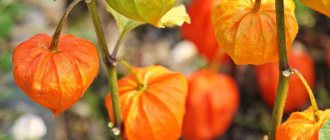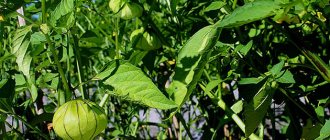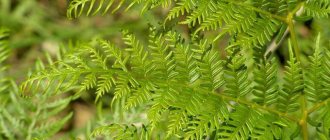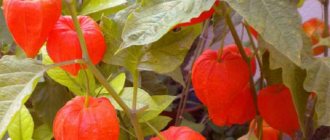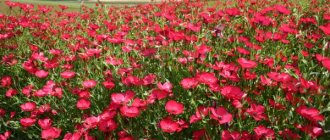Many of us are familiar with beautiful thin branches with bright orange lantern cups, which are used to decorate the interior. They are popularly called Chinese lanterns. This is a physalis plant. Red glossy berries are hidden under the beautiful caps. Branches with miniature fruits are also often used for decorative purposes. It turns out that there are also edible species of this plant that are very beneficial for health.
What does it look like
Physalis is a perennial plant belonging to the Solanaceae family (which also includes tomatoes, potatoes, and eggplants). Moreover, this is the largest genus of all members of the family. The plant is low - 60-100 cm, with a grassy stem that becomes woody at the root. The roots of the perennial branch well, and bushes quickly grow in place of the shoots. The leaves are wide, with pointed ends, teeth along the edges. During flowering, the buds produce bell-shaped, cream- or vanilla-colored cinquefoils. When flowering ends, a small ball-shaped fruit is formed from the ovary. It is covered on all sides with leaves that fold into a neat little case. The property of hiding the fruit in a calyx is a distinctive feature of physalis.
The sepals grow faster than the internal contents. When the fruit is fully ripe, the shell changes color and becomes dry. Initially, the calyx has a light green color, then it changes to yellow-orange, scarlet, purple, depending on the variety. The color of the fruit is approximately in the same color range.
Outwardly, they look like cherries or cherry tomatoes. Their weight depends on the variety and ranges from 2-10 grams. The fruits of vegetable varieties that are grown for harvest are much larger - they can weigh up to 90 g. According to the botanical classification, the fruit of physalis is a berry, but in common parlance it is often called a vegetable.
Bouquet for the winter from physalis. Decorative physalis
Decorative physalis is an unpretentious perennial with an elongated stem completely covered with bright orange “lanterns”.
This plant also has edible relatives: vegetable and dessert varieties. The vegetable variety is canned instead of tomatoes in lean years. And the fruits of strawberry physalis are used for compotes and jams.
Ornamental physalis has many other names - field cherry, Jewish cherry, winter cherry, Chinese lantern. And the eternal romantics of the French dubbed this plant L'amour en cage - “love in a cage.”
And for good reason: if the orange box of physalis falls into water or under heavy rain, it loses its protective layer, and only a weightless openwork “skeleton” remains - a cage in which a small fruit of a rich red color rolls around.
A juicy allegory suggests itself: love, enclosed in a light “silver cage”.
This type of physalis requires the most standard care: watering and periodic removal of weeds. Colorado beetles do not bother him at all, although he belongs to the same family as potatoes, tomatoes and eggplants.
But the main charm of this culture lies in its decorativeness. When dry, the lanterns do not lose their amazing brightness all winter long. A winter bouquet of decorative physalis does not even need additional decoration with other dried flowers.
Or you can cut off shoots with partially ripened bolls, and then you will have green, red and orange lanterns hanging on each branch. If you carefully cut the flashlight with nail scissors and open it, you will get cute little and durable “flowers”.
To make the leaves of the box transparent, you can resort to the so-called skeletonization - a term familiar to every florist.
To do this, lanterns are dipped in a boiling soda solution (two tablespoons of the substance per half liter of water) and cooked over low heat for 30 minutes.
Then each lantern is opened along the venation lines and a small tomato fruit is removed. After this, using light tapping with a soft brush, carefully remove the remaining bright skin, periodically rinsing with water. As a result, you will be left with only a web of tiny veins.
It is also recommended to place the bare flashlights on a sheet of white paper, on which all flaws in the cleaning will be clearly visible, and in the same way remove all remnants of the red film.
Next, all you have to do is dry the handmade products, placing them between several layers of paper and placing them under a press. Such blanks will add zest to any flower arrangement, especially if you make their color more expressive with the help of aerosol paints.
I would like to note that decorative physalis is used exclusively for decoration and is not suitable for consumption (its fruits are poisonous).
But this plant requires the least care and attention from the gardener and will delight the eye with its picturesque lanterns for many years.
Then each lantern is opened along the venation lines and a small tomato fruit is removed. After this, using light tapping with a soft brush, carefully remove the remaining bright skin, periodically rinsing with water. As a result, you will be left with only a web of tiny veins.
Varieties
There are decorative and edible plant species. The former are used to decorate the landscape and arrange bouquets, the latter - in cooking and folk medicine. In total, 120 varieties of physalis are known. They differ in fruit size, taste, and cup color. The most popular decorative species is common physalis. Botanical name: Physalis alkekengi. It is also called Physalis Franchet. René Franchet is a botanist from France who discovered and studied this plant in the late 19th century. A characteristic feature of decorative species is beautifully located cups of regular shape with a diameter of 60-70 mm. The berries of these varieties are not eaten, as they are poisonous.
Food species of the plant are divided into berry and vegetable according to the size of the fruit and taste properties. Vegetables have a bitter skin; it is removed when cooking. Berry fruits have a sweet taste; preserves and jams are made from them. The Mexican variety is a vegetable variety. It tastes like regular tomatoes. The fruits are large, yellow, light green, purple. Popular berry varieties:
- Strawberry
- Pineapple
- Confectionery
- Plum
- Korolek
They can be eaten fresh without heat treatment. Edible varieties have more faded colors than decorative ones. The taste of the berries is mainly sweet, with sourness. Some types have a spicy taste.
Reviews
I didn’t even know what these flowers were called before. Unusual flowers. They usually bloom in autumn. I often see them in the flower beds at the entrance, and two years ago we planted them in my parents’ garden. I remember, as a child, we picked these flowers and then opened them, apparently, we wanted to find a surprise. The flower itself looks like a paper lantern. Looks beautiful in autumn. The plant is unpretentious and does not require special care.
Elechka Elechka
https://flap.rf/%D0%96%D0%B8%D0%B2%D0%BE%D1%82%D0%BD%D1%8B%D0%B5_%D0%B8_%D1%80%D0 %B0%D1%81%D1%82%D0%B5%D0%BD%D0%B8%D1%8F/%D0%A4%D0%B8%D0%B7%D0%B0%D0%BB%D0% B8%D1%81/%D0%9E%D1%82%D0%B7%D1%8B%D0%B2%D1%8B/6022723
And what flashlights? Previously, I often saw this plant dried in a vase. At first I thought it was just an artificial flower. And how the lanterns hang beautifully. At work, I often exchange flowers and bushes with my co-workers. One gave me physalis. I planted it late in October, I thought it wouldn’t survive. But imagine my amazement when in the spring it began to grow. A friend once told me how delicious physalis fruits are when they ripen. I tried it to taste, I don’t recommend eating it, but you can dry it for decoration. This year I actually thought that this plant had died. But when it began to bloom in September, I was very happy.
Benefit
Physalis fruits have high nutritional value. They contain a lot of vitamin C, K, PP, B1, B6. They contain minerals: magnesium, phosphorus, iron. In addition, they have:
- sucrose
- pectins
- carotenoids
- quercetin
- lycopene
- tannins
- organic acids (malic, citric, caffeic, tartaric)
Thanks to the vitamin complex contained in physalis, eating berries has a general strengthening effect on the body and increases resistance to viruses. Dietary fiber contained in the pulp helps the digestion process, increases intestinal motility, and removes harmful substances. The fruits of the plant have the following properties:
- anti-inflammatory
- choleretic
- diuretic
- painkiller
- bactericidal
The berries contain antioxidants that prevent healthy cells from degenerating into atypical ones, thereby preventing the development of cancer. Vitamins B and C have a positive effect on the functioning of the central nervous system and strengthen the cellular structure. Nicotinic acid prevents the formation of cholesterol plaques inside blood vessels. Potassium regulates blood pressure and accelerates metabolic processes in cells. The juice secreted by the fruit helps heal wounds on the skin. With the help of decoctions and tinctures of edible types of berries, diseases such as:
- bronchitis, colds, flu;
- cystitis, prostate;
- dermatophytosis, skin mycosis;
- kidney stone disease;
- hypertension.
Possible diseases and pests
Physalis has high disease resistance. Sometimes, due to irregularities in care or unfavorable weather, infection with mosaic, phytosporosis, or from excess moisture - blackleg can occur. The “mosaic” bush is dug up, the soil under it and neighboring plants are treated with a fungicide. Do the same if you are affected by blackleg. For phytosporosis, they are treated with Bordeaux mixture for preventive purposes.
Wireworm and mole cricket larvae can damage the root system. For prevention, the soil is regularly loosened, insect traps are installed, and substances with a pungent odor (naphthalene, sand soaked in kerosene) are poured into the furrows.
Traditional medicine recipes
To treat various pathologies, the following types of drinks are used: tea, decoction, alcohol tinctures, freshly squeezed juice.
Berry decoction
25 g of dried physalis fruits are poured with boiling water in a volume of 400 ml, the dishes are placed on low heat. Without bringing to a boil, keep covered for 15 minutes. Then remove from the stove, cool and filter. The decoction is taken in a third of a glass 2-3 times a day for diseases of the respiratory tract, kidneys, and stomach pain.
Ointment
To heal cuts, relieve inflammation on the skin, and eliminate joint pain, this composition is made. The berries are finely chopped or crushed in a blender. Add olive oil in a 1:1 ratio and mix well. The mixture is infused in a dark place for three weeks, then the mass is squeezed out and the cake is removed. The ointment is applied to the affected areas 2-3 times a day until the symptoms disappear.
Planting and caring for Physalis in open ground
The flower takes root well in our climate zone, caring for it is not labor-intensive, even beginner, inexperienced gardeners can handle it.
The Physalis flower is very easy to care for. The plant needs periodic watering, but does not like an overly humid environment. It needs to be planted in an open, sunny space. There are no special preferences for soil; garden, fertile soil is perfect. The soil should be well drained and moisture permeable. The flower needs to be regularly fed with organic fertilizers. Substances are added to the soil after watering it. It is also necessary to periodically loosen the soil to remove weeds.
Growing Physalis from seeds
The seed propagation option is quite simple. Physalis seeds have a high percentage of similarity over four years. Before sowing, the seeds should be soaked in a light salt solution. The floating seeds are thrown away, the rest are suitable for planting. It is also advisable to soak the seeds for about half an hour in a solution of potassium permanganate before sowing. This disinfects them and will prevent the development of plant diseases.
Seeds are planted in open ground in mid-April and May.
The distance between seeds should be at least 10-15 cm, row spacing - 30 cm. Dense planting will need to be thinned out, keeping a distance between specimens of about 20-25 cm. Autumn sowing of seeds is carried out in October.
Planting Physalis seedlings
Physalis seedlings are grown for planting in mid-latitudes, where April and May can be rainy, with sudden temperature changes. Sow seeds in a container or individual planting cups in mid-March. Before planting, they must be soaked in a solution of potassium permanganate for half an hour. The planting is regularly ventilated and kept in a warm place without drafts. The first shoots appear within a week. Grown seedlings can be fed with organic fertilizers, then they will be stronger and fleshier.
After the appearance of 5-6 strong leaves, the flower seedlings can be transplanted to the main place of growth.
The weather will tell you when to plant Physalis in open ground. The earth should warm up well, and the possibility of morning frosts and sudden cold snaps should also be excluded. Seedlings are often planted in the garden in the middle or end of May. A crop planted with seedlings will bloom faster and the harvest will be early.
Tall species need a garter. This must be taken into account when planting. Such bushes are often branched; the distance between specimens is at least half a meter.
Plant propagation
The flower reproduces by vegetative, seed method. An adult bush can be divided into several parts, each of which should contain several healthy shoots. The separated parts are immediately planted in the ground and quickly take root. A quick way to propagate a plant is by planting cuttings. To do this, choose the top, healthy shoots. It is better to prepare planting material in July. Cut branches with 2-3 developed internodes are deepened into the soil to half their height and covered with a protective cap. Periodically ventilate and moisten the planting. In a few weeks, the root system will begin to develop, and the shoot will produce new shoots.
As it is
Physalis fruits are used both as berries and vegetables. Vegetable varieties are canned, fried, stewed, and added to first courses. Berry varieties contain pectin, which has gelling properties. Therefore, they are often used to make jams. They are also used to make:
- jam
- jelly
- marshmallow
- marmalade
- candies
- jelly
You can eat both varieties fresh. Vegetable types of fruits are dried, salted for the winter, pickled, and caviar is prepared from them. The berries are dried, ground with sugar, made into puddings and purees.
Research [edit | edit code]
The largest Russian scientific organization conducting active research and selection of physalis is VNIISSOK.
The All-Russian Institute of Plant Growing named after N. I. Vavilov has a collection of many species and varieties of physalis.
Decorative physalis, with its bright boxes of orange-red tones, is very reminiscent of Chinese lanterns and immediately creates a feeling of celebration. For this reason, he has quite a following. But those who did not take physalis also have their own arguments - the fruits of the plant are poisonous.
Recipes
Before pickling, the fruits are washed under running water, damaged and wrinkled ones are selected. To make caviar and jam, you can use slightly overripe fruits.
Pickled Physalis
Before marinating, you need to prepare a sterilized glass container. Place on the bottom of the jars: two garlic cloves, a few black peppercorns, a bay leaf, a sprig of any garden herb, half a red chili pepper. Then the container is filled with physalis berries, placed tightly to each other. All ingredients are poured with boiling water. After 15 minutes, pour the water from the jars into a saucepan, add one teaspoon of salt and sugar to each jar. After the composition begins to boil, it is again poured into jars. Immediately close with airtight lids.
Sauce
This spicy sweet and sour gravy serves as an accompaniment to steaks. You will need: a cup of pineapple physalis, two sweet crumbly apples, juice of half a lemon, 30 ml of liquid honey, salt, pepper, several cilantro seeds. Apples need to be peeled, seeds removed, and finely chopped. Add crushed berries to them and simmer in mustard oil until brown. Then add seasonings and simmer for another 5-10 minutes under the lid. Then reduce the heat to minimum, add honey, pour in lemon juice, and simmer for 2-3 minutes.
Candied fruit
To prepare the dish, take strawberry varieties. For two kilograms of fruit, syrup is prepared from 2.5 kg of granulated sugar and 600 ml of water. Bring the mixture to a boil, pour in the berries. It is cooked for 10 minutes over low heat. After this, the mass rests for 5 hours. Then the procedure is repeated. After re-cooking, transfer the berries to a colander and allow the liquid to drain. The syrup can be used to make compote. The fruits are sprinkled with powdered sugar and dried in the oven at a temperature of 30-40 degrees for 2-3 hours.
Caviar
For one kilogram of physalis vegetable varieties, take 600 g of carrots, 300 g of onions. The root vegetables are grated, transferred to a deep frying pan, and fried in olive or camelina oil for 4-5 minutes. Physalis is blanched and the skin is removed. Then they are finely chopped or blended and added to vegetables. All ingredients are simmered together until soft. Towards the end of cooking, add salt, sugar and seasonings to taste.
Cocktail “Fruit Explosion”
You will need the following ingredients: strawberry physalis, mango, passion fruit, ice cream, fruit liqueur, ice. Fruits need to be peeled, seeds removed, and cut into pieces. Beat the slices in a blender along with the ice cream. The mixture is poured into a glass, a spoonful of liqueur is added, and stirred. Ice is placed on top and garnished with physalis berries.
Reproduction options
If there is at least one physalis bush on the site, then it can be propagated by cuttings or shoots. The rhizome of decorative physalis is creeping, located close to the surface and it is easy to separate one or several shoots from it, of which many are formed. In spring or autumn, a part of the rhizome with a shoot is cut off, planted in a prepared hole, and watered. To retain moisture, apply a layer of mulch.
Cuttings are cut in July, selecting the apical part of the shoot with 2-3 internodes. Root in loose soil, deepening to ½ length. Cover the top with a jar of transparent material. The greenhouse is removed when the leaves become elastic. The seedlings are watered and protected from the bright sun.
Interesting Facts
In some countries, physalis is a symbol of love and desired pregnancy. In Europe, there is a beautiful custom of giving physalis. It is customary to present a bouquet of Chinese lanterns to a girl with whom a man wants to have a child. Branches with orange buds are also given to pregnant women - cups with berries hidden inside symbolize the fetus in the mother's womb. The wife's relatives can present such a bouquet to the future father as a sign of gratitude for the successful conception.
There is a Chinese legend about the origin of the physalis plant. In ancient times, an evil dragon swallowed the sun. Darkness reigned on Earth, people could not find each other, animals began to die. There was a brave soul who decided to return the sun to all living things. He took a lantern and went in search of the dragon. The young man wandered for a long time, and, finding an evil monster, killed him. The sun soared up, and the hero, blinded by its rays, dropped the lantern to the ground. As it fell, it turned into thousands of small lanterns that rolled across the ground and hung on the blades of grass.
There is a sign that a bouquet of physalis placed in the house drives away evil spirits and attracts prosperity and comfort. This beautiful plant fills you with positivity just by looking at its cheerful orange lanterns.
Who do they go to?
The noble red color is universal. Warm and light tone, dark or pale skin, eyes of any color, any face shape - you can always choose the color. It’s easier to say who the sunny palette doesn’t suit, especially since there are only two contraindications – gray hair and easily inflamed skin.
On gray strands, as well as on dry and brittle ones, the red color will not last. As a result, the coloring will not be uniform, and the shade will change literally immediately.
To determine exactly which color to choose, you need to set your color type.
On the video, shades of red hair colors:
Description
Physalis vulgaris A perennial herbaceous plant of the Solanaceae family, 30-60 to 120 cm high.
The stem is straight or creeping, branched.
The lower leaves are alternate, the upper leaves are opposite, ovoid, sometimes pubescent, located on petioles.
Blooms in May - June. The flowers are solitary, located in the axils of the upper leaves. The flowers are greenish-yellow in color.
The fruit is up to 5 cm in diameter, an orange-red spherical berry, covered with a calyx that has grown again in the form of a bubble and is colored fiery red. The fruit contains many seeds. Ripens in August - September. The surface of the fruit is sticky.
Spreading
Physalis vulgaris grows in the European part of Russia, the Far East, the North Caucasus, Transcaucasia and Central Asia. It is found in light forests, among shady bushes, near populated areas, as well as along the roadsides, fields and vineyards. In the southern regions of our country it forms continuous thickets. It has been cultivated in Europe for more than two centuries. Physalis is especially widespread in France, where it is used as a raw material for confectionery products. It grows wild in Mexico and Guatemala. In our country it grows as a weed in the south of Ukraine and the Black Sea coast of the Caucasus. In the Stavropol region, Mexican physalis grows in forests.
Features of cultivation
Caring for physalis is not difficult, since the culture is very unpretentious. The plant prefers light, fertile soils and a sunny place, although it tolerates partial shade well. In the early stages of growth, it is necessary to protect the bushes from low temperatures. Strong plants do not need protection. The crop does not like strong humidity, so watering once a week is enough and can only be increased during dry periods. When fruits begin to set on the bush, irrigation is stopped altogether.
Rotted manure and bird droppings are used as fertilizer. Fertilizing is carried out after watering the soil 3 times per season: during budding and flowering, when fruits appear and 3 weeks after the second fertilizing. In the absence of such fertilizers, before planting seedlings, the soil can be dug up with wood ash. The plant is quite resistant to diseases and pests.
Indoor nightshade: the secret of the plant's attractiveness
Orange lanterns in the autumn garden: how to properly grow decorative physalis
In its natural environment, nightshade is most often found in regions with warm climates. Its homeland is South America, where it reaches a meter in height. In some countries, such as Australia, the plant is destroyed because it is considered a weed. Despite this, indoor nightshade attracts lovers of house plants.
The flower grows to about 30 cm. From the outside it resembles a small bush. The oblong, lanceolate-shaped foliage has a rich dark green color, against which clearly defined veins are visible. The edges of the plates have a wavy frame, which gives the bush a spectacular look.
During the flowering period, buds appear on the branches of indoor nightshade. They can grow in inflorescences of several pieces or singly. It is interesting that flowering occurs at different times during the warm season, but the berries appear in winter. Their dimensions are approximately 1.5 cm. The color when ripe can be from bright red to orange. From the outside it looks very beautiful. Against the background of dark green leaves, scarlet beads shine with bright lights, which remain on the shoots for several months. They do not wither or fall off.
